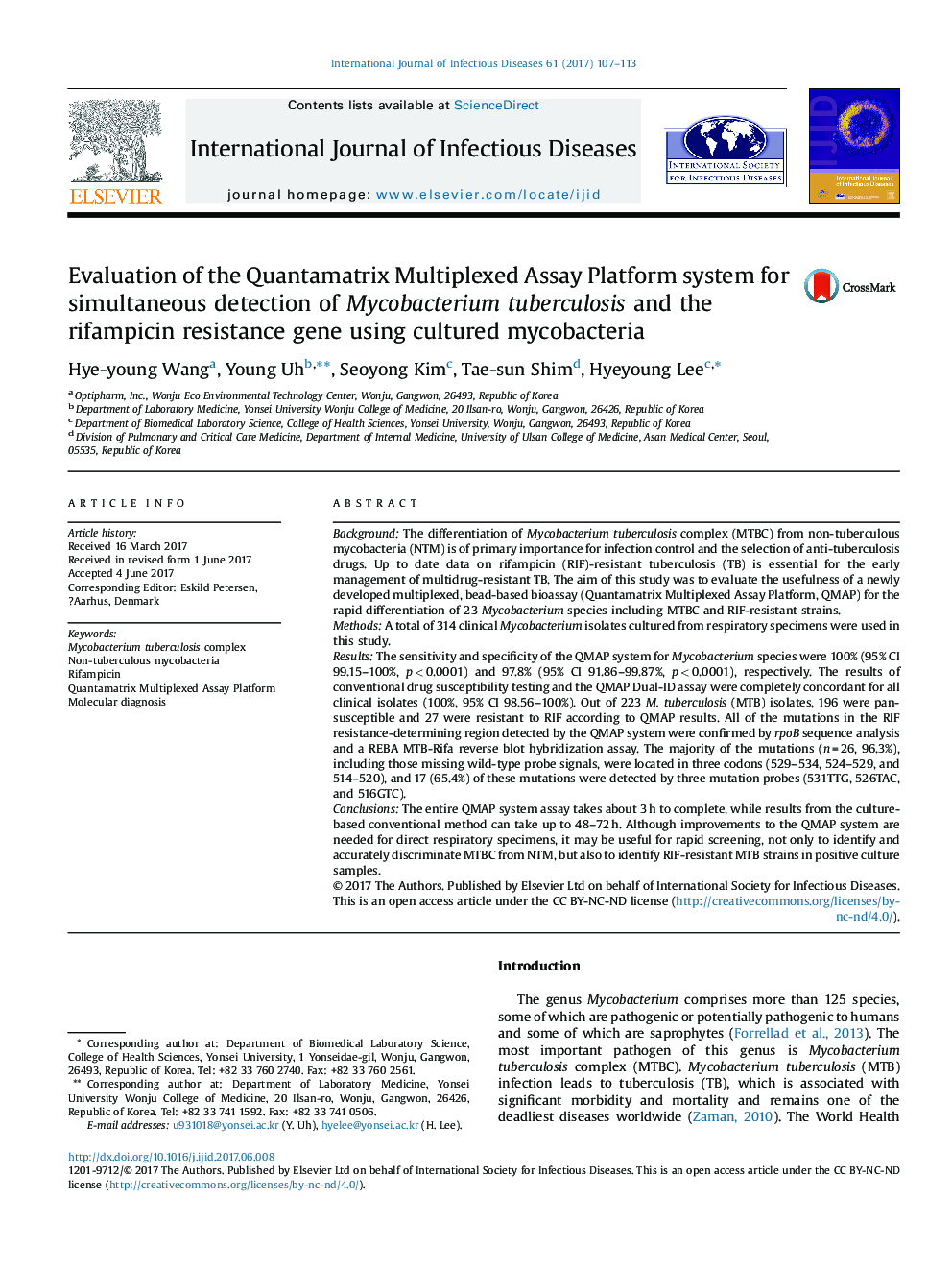| Article ID | Journal | Published Year | Pages | File Type |
|---|---|---|---|---|
| 5667392 | International Journal of Infectious Diseases | 2017 | 7 Pages |
â¢Mycobacteria are an important cause of morbidity in humans. Rapid and accurate mycobacterial identification is important for improving patient outcomes. However, identification of Mycobacterium species is not easy, due to the slow and fastidious growth of mycobacteria.â¢The usefulness of a newly developed multiplexed, bead-based bioassay (Quantamatrix multiplexed Assay Platform; QMAP) for the rapid differentiation of 23 Mycobacterium species including Mycobacterium tuberculosis complex and rifampicin-resistant strains was evaluated.â¢The overall sensitivity and specificity of the QMAP system for the identification of Mycobacterium species were 100% (95% CI 99.15-100%, p < 0.0001) and 97.8% (95% CI 91.86-99.87%, p < 0.0001), respectively.â¢The results of conventional drug susceptibility testing and the QMAP Dual-ID assay were completely concordant for all clinical isolates (100%, 95% CI 98.56-100%).â¢The QMAP system is a useful tool for the rapid differentiation between MTBC and NTM strains and for the clear identification of Mycobacterium species and RIF-resistant MTB as causative agents of disease, facilitating a rapid selection of the appropriate therapeutic response.
BackgroundThe differentiation of Mycobacterium tuberculosis complex (MTBC) from non-tuberculous mycobacteria (NTM) is of primary importance for infection control and the selection of anti-tuberculosis drugs. Up to date data on rifampicin (RIF)-resistant tuberculosis (TB) is essential for the early management of multidrug-resistant TB. The aim of this study was to evaluate the usefulness of a newly developed multiplexed, bead-based bioassay (Quantamatrix Multiplexed Assay Platform, QMAP) for the rapid differentiation of 23 Mycobacterium species including MTBC and RIF-resistant strains.MethodsA total of 314 clinical Mycobacterium isolates cultured from respiratory specimens were used in this study.ResultsThe sensitivity and specificity of the QMAP system for Mycobacterium species were 100% (95% CI 99.15-100%, p < 0.0001) and 97.8% (95% CI 91.86-99.87%, p < 0.0001), respectively. The results of conventional drug susceptibility testing and the QMAP Dual-ID assay were completely concordant for all clinical isolates (100%, 95% CI 98.56-100%). Out of 223 M. tuberculosis (MTB) isolates, 196 were pan-susceptible and 27 were resistant to RIF according to QMAP results. All of the mutations in the RIF resistance-determining region detected by the QMAP system were confirmed by rpoB sequence analysis and a REBA MTB-Rifa reverse blot hybridization assay. The majority of the mutations (n = 26, 96.3%), including those missing wild-type probe signals, were located in three codons (529-534, 524-529, and 514-520), and 17 (65.4%) of these mutations were detected by three mutation probes (531TTG, 526TAC, and 516GTC).ConclusionsThe entire QMAP system assay takes about 3 h to complete, while results from the culture-based conventional method can take up to 48-72 h. Although improvements to the QMAP system are needed for direct respiratory specimens, it may be useful for rapid screening, not only to identify and accurately discriminate MTBC from NTM, but also to identify RIF-resistant MTB strains in positive culture samples.
